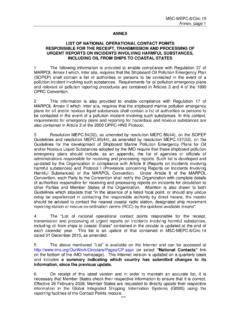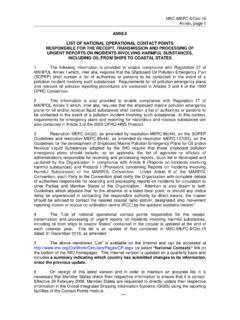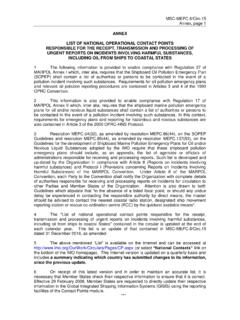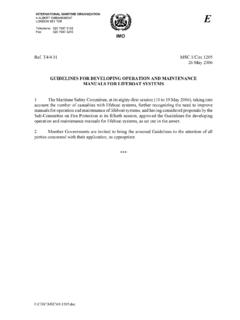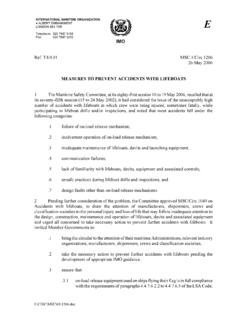Transcription of ANNEX 8 RESOLUTION MEPC.76(40) adopted on …
1 mepc 40/21 ANNEX 8 RESOLUTION (40) adopted on 25 September 1997 STANDARD specification FOR shipboard incinerators THE MARINE environment protection COMMITTEE, RECALLING Article 38(c) of the Convention on the International Maritime Organization concerning the function of the Committee, RECALLING ALSO that ANNEX V of the International Convention for the Prevention of Pollution from Ships, 1973, as modified by the Protocol of 1978 relating thereto (MARPOL 73/78), provides regulations for the prevention of pollution by garbage from ships, RECOGNIZING that the Assembly at its seventeenth session adopted RESOLUTION (17) on prevention of air pollution from ships, and requested the Committee and the Maritime Safety Committee to develop environmentally based standards for incineration of garbage and other ship-generated waste, RECOGNIZING ALSO that the Committee, at its thirty-third session, adopted RESOLUTION (33)
2 - Revised Guidelines for the Implementation of ANNEX V of MARPOL 73/78, which included the original text of the Standard specification for shipboard incinerators , NOTING that the Conference of Parties to MARPOL 73/78, held in conjunction with mepc 40, adopted the Protocol of 1997 to amend MARPOL 73/78, including its ANNEX VI - Regulations for the Prevention of Air Pollution from Ships, BEING AWARE that the regulation 16(2) on shipboard incinerators within ANNEX VI to MARPOL 73/78 includes reference to mandatory operating limits for shipboard incinerators as contained in appendix IV to ANNEX VI and approval of such incinerators by the Administration to be based on the standard specification developed by the Organization, ALSO BEING AWARE that regulation 16 of ANNEX VI of MARPOL 73/78 prohibits shipboard incineration of certain substances, HAVING CONSIDERED the recommendations by the Sub-Committee on Ship Design and Equipment at its fortieth session regarding the Standard specification for shipboard incinerators , 1.
3 ADOPTS the Standard specification for shipboard incinerators , the text of which supersedes Appendix 2 to the Revised Guidelines for the Implementation of ANNEX V of MARPOL 73/78, adopted by RESOLUTION (33), and which is set out at ANNEX to this RESOLUTION ; and 2. URGES Governments to apply the Standard specification for shipboard incinerators when implementing the provisions of Annexes V and VI of MARPOL 73/78. mepc 40/21 ANNEX 8 Page 2 ANNEX STANDARD specification FOR shipboard incinerators Table of Contents 1 Scope 2 Definitions 3 Materials and manufacture 4 Operating requirements 5 Operating controls 6 Other requirements 7 Tests 8 Certification 9 Marking 10 Quality assurance ANNEX A1 - Emission Standard for shipboard incinerators A2 - Fire protection Requirements for incinerators and Waste Stowage Spaces A3 - incinerators integrated with heat recovery units A4 - Flue gas temperature mepc 40/21 ANNEX 8 Page 3 STANDARD specification FOR shipboard incinerators 1 Scope This specification covers the design, manufacture, performance.
4 Operation and testing of incinerators intended to incinerate garbage and other shipboard wastes generated during the ship's normal service. This specification applies to those incinerator plants with capacities up to 1,500 kW per unit. This specification does not apply to systems on special incinerator ships, , for burning industrial wastes such as chemicals, manufacturing residues, etc. This specification does not address the electrical supply to the unit, nor the foundation connections and stack connections. This specification provides emission requirements in ANNEX A1, and fire protection requirements in ANNEX A2. Provisions for incinerators integrated with heat recovery units and provisions for flue gas temperature are given in ANNEX A3 and ANNEX A4, respectively.
5 This specification may involve hazardous materials, operations, and equipment. This standard does not purport to address all of the safety problems associated with its use. It is the responsibility of the user of this standard to establish appropriate safety and health practices and determine the applicability of regulatory limitations prior to use, including possible port State limitations. 2 Definitions Ship means a vessel of any type whatsoever operating in the marine environment and includes hydrofoil boats, air-cushioned vehicles, submersibles, floating craft and fixed or floating platforms. Incinerator means shipboard facilities for incinerating solid wastes approximating in composition to household waste and liquid wastes arising from the operation of the ship, , domestic waste, cargo-associated waste, maintenance waste, operational waste, cargo residues, and fishing gear, etc.
6 These facilities may be designed to use or not to use the heat energy produced. Garbage means all kinds of victual, domestic and operational waste excluding fresh fish and parts thereof, generated during normal operation of the ship as defined in ANNEX V to MARPOL 73/78. Waste means useless, unneeded or superfluous matter which is to be discarded. Food wastes are any spoiled or unspoiled victual substances, such as fruits, vegetables, dairy products, poultry, meat products, food scraps, food particles, and all other materials contaminated by such wastes, generated aboard ship, principally in the galley and dining areas. Plastic means a solid material which contains as an essential ingredient one or more synthetic organic high polymers and which is formed (shaped) during either manufacture of the polymer or the fabrication into a finished product by heat and/or pressure.
7 Plastics have material properties ranging from hard and brittle to soft and elastic. Plastics are used for a variety of marine purposes including, mepc 40/21 ANNEX 8 Page 4 but not limited to, packaging (vapour-proof barriers, bottles, containers, liners), ship construction (fibreglass and laminated structures, siding, piping, insulation, flooring, carpets, fabrics, paints and finishes, adhesives, electrical and electronic components), disposable eating utensils and cups, bags, sheeting, floats, fishing nets, strapping bands, rope and line. Domestic waste means all types of food wastes, sewage and wastes generated in the living spaces on board the ship for the purpose of this specification . Cargo-associated waste means all materials which have become wastes as a result of use on board a ship for cargo stowage and handling.
8 Cargo-associated waste includes but is not limited to dunnage, shoring pallets, lining and packing materials, plywood, paper, cardboard, wire, and steel strapping. Maintenance waste means materials collected by the engine department and the deck department while maintaining and operating the vessel, such as soot, machinery deposits, scraped paint, deck sweeping, wiping wastes, oily rags, etc. Operational wastes means all cargo-associated wastes and maintenance waste (including ash and clinkers), and cargo residues defined as garbage in Sludge oil means sludge from fuel and lubricating oil separators, waste lubricating oil from main and auxiliary machinery, waste oil from bilge water separators, drip trays, etc.
9 Oily rags are rags which have been saturated with oil as controlled in ANNEX I to the Convention. Contaminated rags are rags which have been saturated with a substance defined as a harmful substance in the other Annexes to MARPOL 73/78. Cargo residues for the purposes of this standard are defined as the remnants of any cargo material on board that cannot be placed in proper cargo holds (loading excess and spillage) or which remains in cargo holds and elsewhere after unloading procedures are completed (unloading residual and spillage). However, cargo residues are expected to be in small quantities. Fishing gear is defined as any physical device or part thereof or combination of items that may be placed on or in the water with the intended purpose of capturing, or controlling for subsequent capture, living marine or freshwater organisms.
10 3 Materials and manufacture: The materials used in the individual parts of the incinerator are to be suitable for the intended application with respect to heat resistance, mechanical properties, oxidation, corrosion, etc., as in other auxiliary marine equipment. Piping for fuel and sludge oil should be seamless steel of adequate strength and to the satisfaction of the Administration. Short lengths of steel, or annealed copper nickel, nickel copper, or copper pipe and tubing may be used at the burners. The use of nonmetallic materials for fuel lines is prohibited. Valves and fittings may be threaded in sizes up to and including 60 mm (outside diameter), but threaded unions are not to be used on pressure lines in sizes 33 mm (outside diameter) and over.




